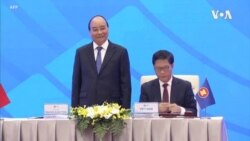ພາຍໃຕ້ລັດຖະບານປະທານາທິບໍດີທຣໍາ ສະຫະລັດແມ່ນໄດ້ເພັ່ງເລັງໃສ່ ຄວາມສຳພັນທາງດ້ານການຄ້າສອງຝ່າຍ ແລະໄດ້ຖອນໂຕອອກຈາກພາຄີຂ້າມມະຫາສະມຸດປາຊີຟິກ ຊຶ່ງເປັນຂໍ້ຕົກລົງການຄ້າຫຼາຍຝ່າຍ ທີ່ຊຸກຍູ້ໂດຍລັດ ຖະບານປະທານາທິບໍດີໂອບາມາ ເພື່ອຕໍ່ຕ້ານອິດທິພົນຂອງຈີນຢູ່ໃນເຂດເອເຊຍ ປາຊີຟິກ. Patsy Widakuswara ນັກຂ່າວວີໂອເອປະຈຳທຳນຽບຂາວ ຈະພາ ທ່ານສຳຫຼວດເບິ່ງ ບັນຫາທ້າທາຍທາງດ້ານການຄ້າ ຢູ່ໃນຂົງເຂດທີ່ມີຕໍ່ທ່ານໂຈ ໄບເດັນ ປະທານາທິບໍດີທີ່ໄດ້ຮັບເລືອກໃໝ່ ຂອງສະຫະລັດ ຊຶຶ່ງໄດ້ປະກາດວ່າ ຈະກັບຄືນໄປສູ່ນະໂຍບາຍ ການຕົກລົງຫຼາຍຝ່າຍ ແລະເຮັດວຽກຮ່ວມກັບພັນທະມິດ ເພື່ອຂຽນກົດລະບຽບການຄ້າລະຫວ່າງປະເທດຄືນໃໝ່ ດັ່ງໄພສານ ຈະນຳເອົາລາຍລະອຽດມາສະເໜີທ່ານ ໃນອັນດັບຕໍ່ໄປ.
ໃນເດືອນພະຈິກຜ່ານມານີ້ 15 ປະເທດໃນເຂດເອເຊຍປາຊີຟິກ ໄດ້ລົງນາມໃນພາຄີຮອບດ້ານທາງເສດຖະກິດປະຈຳພູມີພາກ ທີ່ເອີ້ນຫຍໍ້ວ່າ RCEP.
RCEP ແມ່ນຂໍ້ຕົກລົງການຄ້າເສລີ ທີ່ໃຫຍ່ທີ່ສຸດໃນໂລກ ໂດຍມີສະມາຊິກທັງໝົດປະກອບເປັນ 28 ເປີເຊັນຂອງຍອດຜະລິດຕະພັນຮວມພາຍໃນ ຫຼື GDP ຂອງປະຊາຊົນ 2 ພັນ 200 ລ້ານຄົນ.
ສະຫະລັດ ບໍ່ໄດ້ເປັນສະມາຊິກຂອງກຸ່ມ RCEP ຊຶ່ງມີການເບິ່ງກັນຢ່າງກວ້າງຂວາງວ່າເປັນກຸ່ມທາງເລືອກທີ່ໄດ້ຮັບການໜຸນຫຼັງຈາກປັກກິ່ງ ແທນພາຄີຂ້າມມະຫາສະໝຸດປາຊີຟິກ.
ຂໍ້ຕົກລົງການຄ້າປະຈຳຂົງເຂດ ທີ່ໄດ້ມີການສະເໜີໂດຍລັດຖະບານທ່ານໂອບາມານັ້ນແມ່ນບໍ່ມີຈີນເຂົ້າຮ່ວມ. ມີ 12 ປະເທດ ໄດ້ລົງນາມໃນພາຄີ ຂ້າມມະຫາສະໝຸດປາຊີຟິກ ຫຼື TPP ໃນປີ 2016 ກ່ອນປະທານາທິບໍດີທຣຳໄດ້ປະກາດຖອນໂຕ ໃນປີ 2017.
ທ່ານມາກ ມີລີ (Marc Mealy) ແມ່ນຮອງປະທານອະວຸໂສ ຮັບຜິດຊອບດ້ານນະໂຍບາຍຂອງສະພາທຸລະກິດສະຫະລັດ-ອາຊ່ຽນ ກ່າວຜ່ານທາງສະໄກປ໌ວ່າ:
“ພວກເຂົາເຈົ້າຈະບໍ່ພິຈາລະນາກ່ຽວກັບເລື້ອງການຄ້າຫຼືສິ່ງໃດສິ່ງນຶ່ງໃນທຳນອງນັ້ນ ແຕ່ພວກເຂົາເຈົ້າຈະພິຈາລະນາ ກ່ຽວກັບຂໍ້ຕົກລົງເຫຼົ່ານັ້ນວ່າ ຈະສ້າງບາງສິ່ງບາງຢ່າງ ຊຶ່ງບາງທີອາດຈະເປັນໄປໄດ້ໃນດ້ານການຄ້າທີ່ສຳຄັນສຳລັບທຸລະກິດ ການຄ້າ ຂ້າມຊາຍແດນ ຂອງພວກເຮົາ.”
ທ່ານໂຈໄບເດັນ ປະທານາທິບໍດີທີ່ຖືກເລືອກໃໝ່ຂອງສະຫະລັດ ກ່າວກ່ຽວກັບເລື້ອງນີ້ວ່າ:
“ດັ່ງນັ້ນພວກເຮົາຈຶ່ງສາມາດກຳນົດກົດລະບຽບຂອງເສັ້ນທາງ ແທນທີ່ຈະແມ່ນຈີນແລະປະເທດອື່ນໆເປັນຜູ້ບົງການຜົນທີ່ອອກມາ ຍ້ອນວ່າມັນມີແຕ່ເກມດຽວເທົ່ານັ້ນຢູ່ໃນເມືອງນີ້.”
ການນຳໃຊ້ນະໂຍບາຍຫຼາຍຝ່າຍຂອງທ່ານໄບເດັນແມ່ນຈະເປັນການອຳລາໄປຈາກນະໂຍບາຍຂອງປະທານາທິບໍດີທີ່ພວມຈະພົ້ນຕຳແໜ່ງ ທີ່ມັກຈະໃຊ້ນະໂຍບາຍການເຈລະຈາສອງຝ່າຍ ເພື່ອໃຫ້ສອດຄ່ອງກັບແຜນການໆຄ້າ “ອາເມຣິກາມາກ່ອນໝູ່” ຂອງທ່ານ.
ໃນປີ 2018 ທ່ານທຣຳໄດ້ລົງນາມໃນຂໍ້ຕົກລົງການຄ້າກັບເກົາຫຼີໃຕ້ ແລະຂໍ້ຕົກລົງການຄ້າແບບຈຳກັດກັບປະເທດຍີປຸ່ນໃນປີ 2019.
ແຕ່ຈຸດສູນກາງ ໃນນະໂຍບາຍການຄ້າຂອງທ່ານ ແມ່ນການເຮັດສົງຄາມພາສີກັບປະເທດຈີນ. ປະທານາທິບໍດີດໍໂນລ ທຣຳ ກ່າວກ່ຽວກັບເລື້ອງນີ້ວ່າ:
“ພວກເຮົາໄດ້ເກັບ 25 ເປີເຊັນ ຕໍ່ສິນຄ້າໃນມູນຄ່າ 250 ພັນລ້ານໂດລາ ແລະຫຼັງຈາກນັ້ນຈະຫຼຸດໃນປະລິມານ 10 ເປີເຊັນ ລົງມາເປັນ 7.5 ເປີເຊັນບວກໃສ່ສິນຄ້າໃນມູນຄ່າ 300 ພັນລ້ານໂດລາ.”
ນອກນັ້ນ ທ່ານທຣຳຍັງໄດ້ແນເປົ້າໝາຍໃສ່ບໍລິສັດເທັກໂນໂລຈີຂອງຈີນເຊັ່ນຫົວເຫວີຍໂດຍກ່າວວ່າ ບໍລິສັດໂທລະສັບດັ່ງກ່າວແມ່ນສອດແນມໃຫ້ແກ່ຈີນ. ທ່ານໄດ້ປະສົບຜົນສຳເລັດໃນການຊັກຊວນໃຫ້ອັງກິດແລະປະເທດນ້ອຍໆຫຼາຍໆປະເທດໃນຢູໂຣບ ຫ້າມບໍ່ໃຫ້ບໍລິສັດຫົວເຫວີຍເຂົ້າຮ່ວມໃນການພັດທະນາຕາໜ່າງ 5 ຈີຂອງປະເທດເຫຼົ່ານັ້ນ.
ແຕ່ແນວໃດກໍຕາມ ການເຄື່ອນໄຫວຂອງທ່ານທຣຳ ບໍ່ໄດ້ເຮັດໃຫ້ ການຂາດດຸນການຄ້າຂອງສະຫະລັດໂດຍທົ່ວໄປກັບຈີນຫລຸດລົງ ຊຶ່ງໄດ້ມີການເພີ້ມຂຶ້ນໃນລະຫວ່າງທີ່ເກີດໂຣກລະບາດ ຫຼັງຈາກລະດູໃບໄມ້ຫຼົ່ນໃນປີ 2019.
ທ່ານວີແກຣມ ຊິງ (Vikram Singh) ທີ່ປຶກສາອະວຸໂສຂອງໂຄງການເອເຊຍຢູ່ທີ່ສະຖາບັນສັນຕິພາບສະຫະລັດ ກ່າວຜ່ານທາງສະໄກປ໌ວ່າ:
“ຂ້າພະເຈົ້າຄິດວ່າ ມັນຍັງເປັນຄຳຖາມຢູ່ ກ່ຽວກັບວ່າ ມີປະສິດທິຜົນສ່ຳໃດ ໃນຄວາມເຂັ້ມແຂງອັນນີ້ ມັນເປັນພຽງແຕ່ຄວາມເຂັ້ມແຂງ ມັນເປັນ ໃນເມື່ອວ່າມັນບໍ່ມີເສັ້ນທາງທີ່ຈະແຈ້ງໄປໜ້າ.”
ສະຫະລັດແລະຈີນໄດ້ລົງນາມໃນຂໍ້ຕົກລົງການຄ້າ ຂັ້ນທີ 1 ໃນເດືອນມັງກອນປີ 2020 ກັບປັກກິ່ງ ໂດຍທີ່ຈີນໄດ້ຕົກລົງຈະຊື້ສິນຄ້າແລະບໍລິການຕ່າງໆຂອງສະຫະລັດ.
ໃນນັ້ນແມ່ນຮວມທັງຜະລິດຕະພັນການກະເສດຕື່ມອີກ 36 ພັນ 500 ລ້ານໂດລາ. ຈີນເບິ່ງແລ້ວບໍ່ຊົງວ່າຈະບັນລຸເປົ້າໝາຍໃນການຊື້ປີນີ້.
ໃນຂະນະທີ່ກຳລັງເກີດວິກິດການໂຄວິດ-19 ຢູ່ນີ້ ໃນໄລຍະຫຼາຍເດືອນຕົ້ນໆ ມີທ່າທາງວ່າທ່ານໄບເດັນຈະເພັ່ງເລັງໃສ່ການເອົາມາດຕະການຕ່າງໆ ທີ່ຮວມທັງການແຈກຢາຍຢາວັກຊີນ ແລະການຟື້ນໂຕຄືນຂອງເສດຖະກິດ. ແຕ່ຄວາມສຳພັນທີ່ໄດ້ຊຸດໂຊມລົງລະຫວ່າງສະຫະລັດກັບຈີນ ຄາດວ່າຍັງຈະດຳເນີນຢູ່ຕໍ່ໄປ.
ທ່ານເອເວັນ ເຣສນິກ (Evan Resnick) ຈາກມະຫາວິທະຍາໄລເທັກໂນໂລຈີນານຢາງ ກ່າວກ່ຽວກັບເລື້ອງນີ້ວ່າ:
“ຄວາມສຳພັນຈະມີການແຂ່ງຂັນກັນເພີ້ມຂຶ້ນ ລະຫວ່າງທັງສອງຝ່າຍວ່າ ໃຜເປັນຜູ້ນຳຂອງປະເທດທັງສອງ. ຄຳຖາມກໍມີຢູ່ວ່າຜູ້ນຳພາທີ່ຢູ່ເທິງສຸດສາມາດຄວບຄຸມບາງສ່ວນ ກ່ຽວກັບເຫດການປະຫວັດສາດແລະສາມາດປະຕິບັດຕົນໄດ້ຢ່າງສົມເຫດສົມຜົນແລະແບບໂຕຈິງໄດ້ຫຼືບໍ່.”
ການເຄື່ອນໄຫວໃດໆກໍຕາມຂອງທ່ານໄບເດັນ ເພື່ອຫລຸດຜ່ອນການເກັບພາສີຈະປະເຊີນກັບ ການຄັດຄ້ານທີ່ສຳຄັນຈາກລັດຖະສະພາ ໂດຍສະເພາະແລ້ວໃນເມື່ອວ່າ ມັນມີຄວາມເປັນເອກກະສັນຈາກທັງສອງພັກ ກ່ຽວກັບການເອົາທ່າທີແບບເຂັ້ມແຂງເພື່ອຕ້ານການມີອິດທິພົນເພີ້ມຂຶ້ນຂອງຈີນ.
Under the Trump administration, the U.S. has focused on bilateral trade relations and withdrawn from the Trans-Pacific Partnership, a multilateral trade agreement promoted by the Obama administration to counter China's influence in the Asia-Pacific region. White House Correspondent Patsy Widakuswara looks at the regional trade challenges for President-elect Joe Biden, who has vowed to return to multilateralism and work with allies to rewrite the rules of international trade.
In November, 15 Asia-Pacific countries signed the Regional Comprehensive Economic Partnership.
RCEP is the world's biggest free-trade deal with members accounting for 28% of global GDP and 2.2 billion people.
The United States is not part of RCEP, widely seen as the Beijing-backed alternative to the Trans-Pacific Partnership....
...a regional trade deal proposed by the Obama administration that excluded China. Twelve countries signed the TPP in 2016 before President Donald Trump withdrew from it in 2017.
Marc Mealy is the Senior Vice President for Policy at the US-ASEAN Business Council.
Marc Mealy: ((Mandatory Courtesy: Skype))
“They won't totally determine all trade or anything like that. But they'll - those agreements will create certain features that will probably be potentially very commercially significant for our businesses, trade, across borders.”
President-elect Joe Biden has pledged not to enter trade agreements until the U.S. makes investments in its workers and infrastructure. But he has signaled he will work with allies on trade.
Joe Biden, U.S. President-elect:
“So that we can set the rules of the road, instead of having China and others dictate outcomes because they are the only game in town.”
Biden’s multilateral approach would be a departure from the outgoing president, who prefers bilateral negotiations in line with his “America First” trade agenda.
In 2018, Trump signed a revised free trade agreement with South Korea, and a limited trade deal with Japan in 2019.
But the centerpiece of his trade policy is the tariff war with China.
President Donald Trump:
"We have 25% on $250 billion worth of goods, and then we're bringing the 10% down to 7.5% on $300 billion worth of goods plus.”
Trump has also targeted Chinese tech firms including Huawei, saying the phone producer will spy for Beijing. He has succeeded in convincing Britain and several other small European countries to exclude Huawei from their next generation 5G networks.
But Trump’s moves have not lowered the overall U.S. trade deficit with China, which has grown during the pandemic after falling in 2019.
Vikram Singh is the senior advisor to the Asia Program at the United States Institute for Peace.
Vikram Singh: ((Mandatory courtesy: Skype))
“I think it's questionable how effective this tough – that’s just about being tough - has been, when there hasn't been a clear way forward.”
The U.S. and China signed a Phase One trade deal in January with Beijing agreeing to ramp up purchases of American goods and services....
….including an additional $36.5 billion of agricultural products. China is unlikely to meet this year’s target.
With the COVID-19 crisis, in his early months Biden will likely focus on immediate measures including vaccine distribution and economic recovery. But the strained U.S.-China relationship is expected to continue.
Evan Resnick teaches international relations at Nanyang Technological University.
Evan Resnick:
"The relationship is going to get increasingly competitive irrespective of who is leading both countries. The question is whether the leadership at the top can exercise some control over historical events and can behave reasonably and pragmatically.”
Any moves by Biden to ease the tariffs would face significant congressional opposition, especially since there is a bipartisan consensus over a tougher approach to contain the rise of China.





